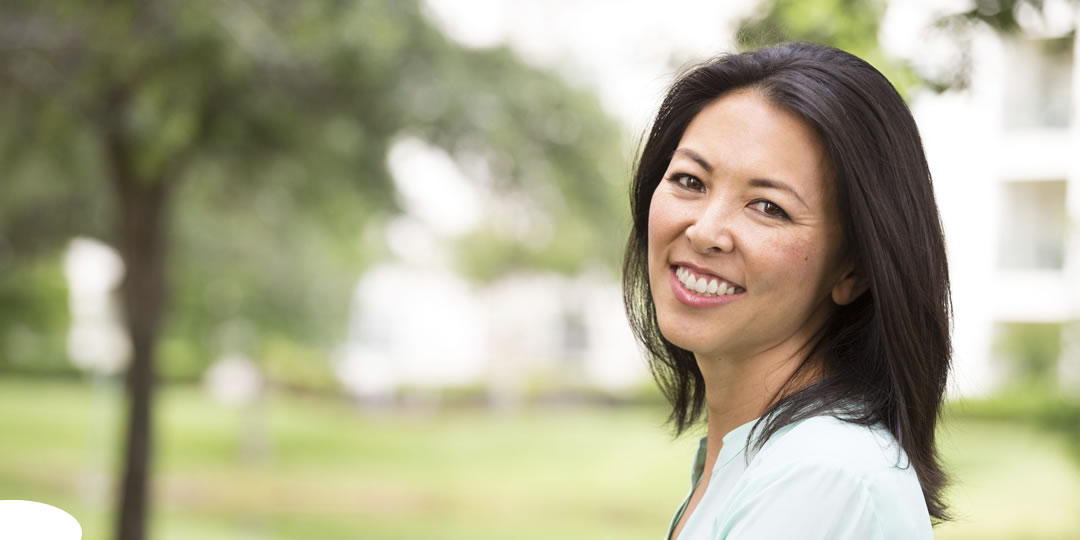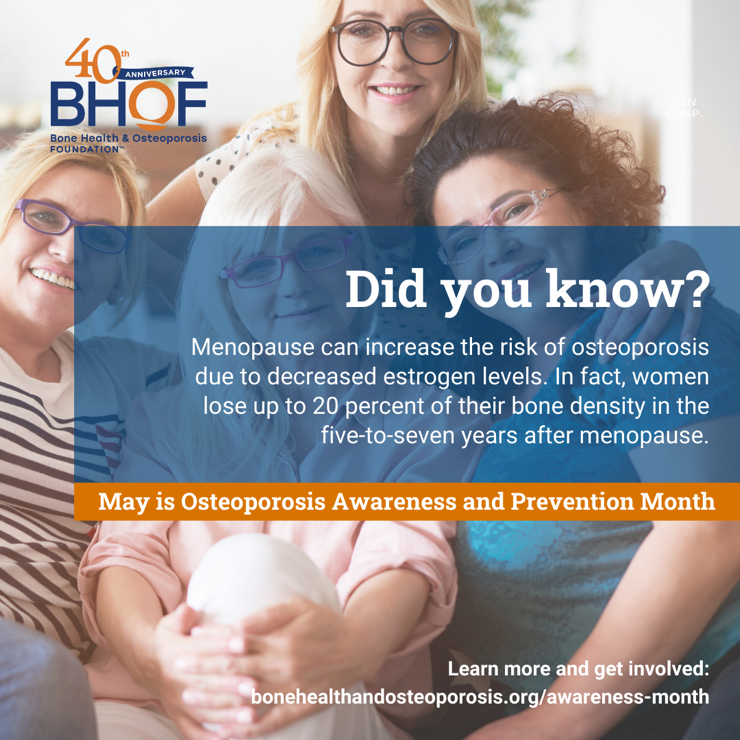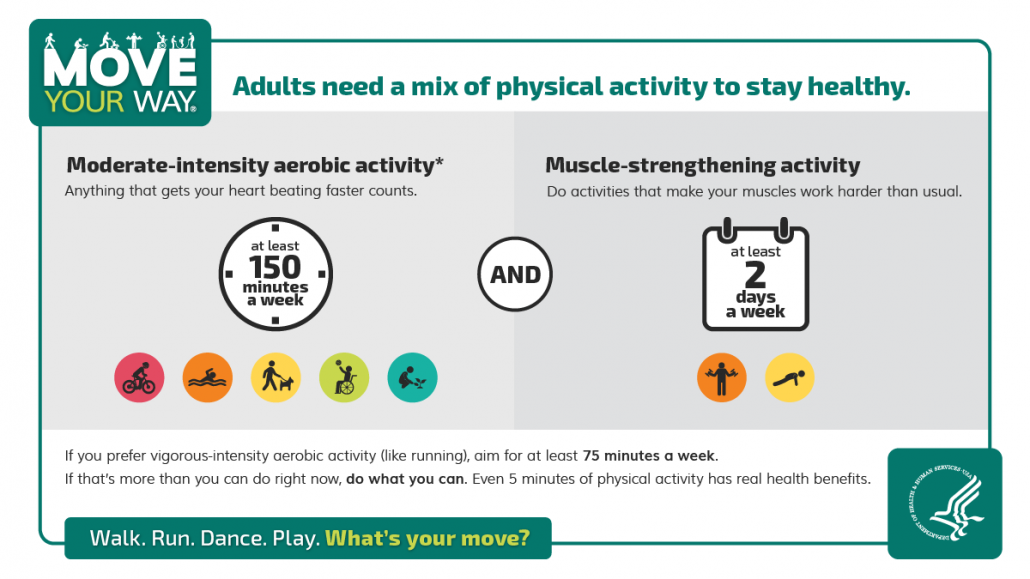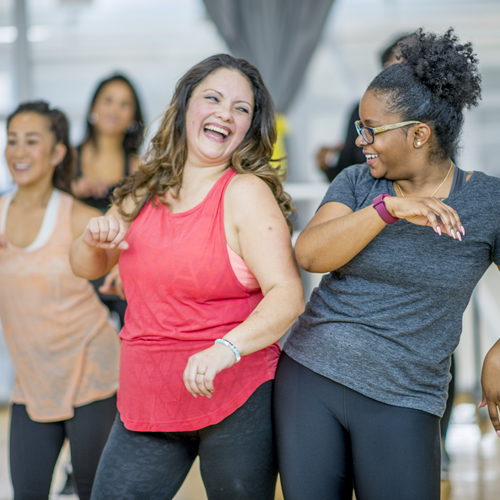“Physical activity refers to all movement including during
leisure time, for transport to get to and from places,
or as part of a person’s work or domestic activities”.1
Umbrella
What may the Physical Activity Umbrella include?
Depending on the Source (DotS) this Umbrella may include:
- Active Living
- Exercise
- Fitness
- Physical Activity
Physical Activity
What is physical activity?
DotS the definition of physical activity may vary. In Physical Activity: Overview the World Health Organization’s (WHO) definition is:
How Much
How much physical activity is recommended?
In Physical Activity: How Much Exercise Do You Need? the (United States) MedlinePlus elaborate on:
On page 56 in Physical Activity Guidelines for Americans, 2nd Edition: Chapter 4. Active Adults – Key Guidelines for Adults the (United States) Department of Health and Human Services include:
- “For substantial health benefits, adults should do at least 150 minutes (2 hours and 30 minutes) to 300 minutes (5 hours) a week of moderate-intensity, or 75 minutes (1 hour and 15 minutes) to 150 minutes (2 hours and 30 minutes) a week of vigorous-intensity aerobic physical activity, or an equivalent combination of moderate- and vigorous-intensity aerobic activity. Preferably, aerobic activity should be spread throughout the week”.4
Moderate-Intensity
What are examples of moderate-intensity amounts of physical activity?
In Guide To Physical Activity the (United States) National Heart, Lung, and Blood Institute give Examples of Moderate-Intensity Amounts of Physical Activity for Common Chores and Sporting Activities.
Vigorous Intermittent Lifestyle Physical Activity
What is vigorous intermittent lifestyle physical activity?
DotS definition of vigorous intermittent lifestyle physical activity (VILPA) may vary. In Vigorous Intermittent Lifestyle Physical Activity and Cancer Incidence Among Nonexercising Adults: The UK Biobank Accelerometry Study – Introduction, published 27 July 2023, the authors’ definition is:
“Vigorous intermittent lifestyle physical activity (VILPA) refers to brief and sporadic (eg, up to 1-2 minutes [min]) bouts of VPA during daily living, eg, bursts of very fast walking or stair climbing”.5
In Physical Activity: Build Physical Activity Into Your Regular Routine MedlinePlus explain:
- At work, try taking the stairs instead of the elevator, walking down the hall to talk with a co-worker instead of sending an email, or adding a 10- to 20-minute walk during lunch
- When you are running errands, try parking at the far end of the parking lot or down the street. Even better, walk to the store or other nearby places
- At home, do chores such as vacuuming, washing the car, gardening, raking leaves, or shoveling snow
- If you ride the bus or other public transportation, get off 1 stop before your usual stop and walk the rest of the way”.6
Gym or Not
What if I am not a gym person?
If you are not a gym person the MedlinePlus explain:
Try joining a dance, yoga, or karate class if it appeals to you. You could also join a baseball or bowling team, or even a mall-walking group. The social aspects of these groups can be rewarding and motivating.
The most important thing is to do exercises that you can maintain and enjoy”.7
Health Benefits
Is there an association between health benefits and physical activity?
Yes. In Physical Activity:Benefits of Physical Activity and Risks of Sedentary Behaviour and Inactivity the WHO includes:
- In adults and older adults, reduced risk of all-cause mortality, risk of cardiovascular disease mortality, incident hypertension, incident site-specific cancers, incident type-2 diabetes, and falls and improved mental health, cognitive health, sleep and measures of body fat; and…”.8
Health Care Provider
What if I am going to start doing physical activity?
If you are going to start doing physical activity, it may be in your best interest to choose to talk to your health care provider about this.
In Physical Activity: Getting Started the MedlinePlus note:
 “IMPORTANT NOTE: Talk with your health care provider before starting an exercise program if:
“IMPORTANT NOTE: Talk with your health care provider before starting an exercise program if:
- You have diabetes, heart disease, lung disease, or another long-term illness
- You have obesity
- You have not been very active lately
- You get chest pains or shortness of breath when you are active”.9
In Fitness: In-Depth – Exercise: 7 Benefits of Regular Physical Activity – The Bottom Line on Exercise the Mayo Clinic caution:
“Remember to check with a health care professional before starting a new exercise program, especially if you have any concerns about your fitness or haven’t exercised for a long time. Also check with a health care professional if you have chronic health problems, such as heart disease, diabetes or arthritis”.10
Health Topics A-Z
Where may I find Health Topics A-Z related to Physical Activity?
In Health Topics A-Z you may find:
Links
Where may I find Links related to Physical Activity?
Your Country may have Links similar to:
Links
This Links List to third party websites is neither comprehensive nor exhaustive. Inclusion on this Links List does not imply endorsement or recommendation. Non-inclusion on this Links List does not imply non-endorsement or non-recommendation. Third party websites are not under the control of Meno Martha International Menopause Directory. Third party websites may contain explicit medical images and/or sexual references. Please read Meno Martha International Menopause Directory’s Links Policy before proceeding to a Link. Please contact Webmaster if you experience a problem with a Link.New or Updated
- Exercise Timing Conundrum: Optimal Workout Timing [07 June 2024]
- Here’s the Right Way To Do A Squat [13 June 2024]
- Should You Try the 7-Minute Workout? [+ Video]
- The 30-30-30 Method: How TikTok’s Latest Fitness Trend Could Help You Build Healthy Habits Into Your Day [31 May 2024]
- Walking vs. Running: Which Is Better for You? [05 June 2024]
- What Are Primal Movement Workouts? [24 July 2024]
- 10 Weight Training Tips for Beginners
- 5 Isometric Exercises You Should Be Doing and Why
- 5 Reasons To Try Nordic Walking
- 5 Surprising Benefits of Walking
- 5 of the Best Exercises You Can Ever Do
- 5 Yoga Poses You Can Do Right Now To Strengthen Your Core
- 6 Desk Exercises That Help You Get Stronger While Working
- 6 Exercises You Can Do In Your Office
- 6 Reasons To Make AMRAP Workouts Part of Your Exercise Routine
- 7 Benefits of Regular Physical Activity
- 7 Reasons To Start Walking In Place
- Active Stretching: What It Is and How To Do It
- BMI Calculator
- Benefits of Exercise
- Benefits of Exercise: What Counts? Keep Healthy With 150 Minutes of Exercise A Week [Video]
- Can Taking A Plunge In Icy Water After Your Workout Be Beneficial?
- Dance Your Way To Fitness
- Exercise
- Exercise: 7 Benefits of Regular Physical Activity
- Exercise Calorie Calculator
- Exercise In Menopause
- Exercise Timing Conundrum: Optimal Workout Timing
- Exercise To Prevent Heart Disease
- Exercise and Immunity
- Exercise and Physical Activity
- Exercise and Physical Fitness
- Exercise for Depression
- Exercise for Your Bone Health
- Exercise, Lifestyle, and Your Bones
- Exercising With Knee or Hip Pain
- FAQs: Staying Active: Physical Activity and Exercise
- Fitness
- Fitness Basics
- Fitness Studio Exercise Videos
- Fitness and Exercise [Topics]
- Fitness: Basics – Fitness: Basics
- Four Types of Exercise Can Improve Your Health and Physical Ability
- Get Active
- Get Moving: Key Takeaways From the New Physical Activity Guidelines
- Getting Active
- Global Action Plan on Physical Activity 2018–2030: More Active People for A Healthier World
- Guide To Physical Activity
- Health Risks of An Inactive Lifestyle
- Help! I’m Too Tired To Exercise
- Here’s the Right Way To Do A Squat
- How Can I Prevent Runners Diarrhea?
- How Often Should You Exercise?
- How SMART Fitness Goals Can Help You Get Healthier
- How To Add Core Exercises To Your Workout Routine
- How To Find ‘Joyful Movement’ In Every Day
- Is It Bad To Do the Same Workout Routine Every Day?
- Is It Normal To Lose Your Period Because of Exercise?
- Learn To Love Exercise
- May Is Osteoporosis Awareness Month

- Mayo Clinic Minute: Aging and the Benefits of Exercising [+ Video Courtesy: Mayo Clinic News Network]
- Mayo Clinic Minute: How To Jump-Start Your Workout [+ Video Courtesy: Mayo Clinic News Network]
- Mayo Clinic Minute: Stacking Your Exercise Over the Weekend [+ Video Courtesy: Mayo Clinic News Network]
- Mayo Clinic Q and A: 5 Elements of A Balanced Fitness Routine
- Mayo Clinic Q and A: 5 Stair Exercises To Do At Home
- Mayo Clinic Q and A: Running and Weight Loss
- Moveyourway [Move Your Way: Walk. Run. Dance. Play. What’s Your Move?]

- Moving Through Menopause: A SAMH Report on Moving Through Menopause [Scottish Association for Mental Health]
- New Video: Get To Know the Move Your Way Campaign!
- Physical Activity
- Physical Activity
- Physical Activity
- Physical Activity
- Physical Activity
- Physical Activity
- Physical Activity Guidelines for Americans
- Physical Activity and Your Mental Health
- Physical Activity: Measuring Physical Activity Intensity
- Physical Activity: Physical Activity Boosts Brain Health
- Physical Activity Basics: Adding Physical Activity As An Adult
- Physical Activity Basics: Benefits of Physical Activity
- Physical Activity Basics: Physical Activity Basics and Your Health
- Physical Activity Basics: Physical Activity and Cancer
- Physical Activity Basics: Physical Activity for Adults: An Overview
- Physical Exercise
- Ready To Run: How To Strengthen Your Core
- Should You Aim To Walk 10,000 Steps a Day?
- Should You Try the 7-Minute Workout? [+ Video]
- Sleep, Food, Exercise, Stress: Why Working on One of These Can Improve the Others
- Swimming for Better Health and To Avoid Injuries [+ Video]
- The 30-30-30 Method: How TikTok’s Latest Fitness Trend Could Help You Build Healthy Habits Into Your Day
- The 4 Most Important Types of Exercise
- The Advantages of Body-Weight Exercise
- The BEEP Program: Keep Your Balance
- The Benefits of Adding A ‘Deload Week’ To Your Workout Plan
- The Exercise Effect
- Tips for Getting More Active Minutes
- WHO Guidelines on Physical Activity and Sedentary Behaviour
- Walking
- Walking for Health
- Walking vs. Running: Which Is Better for You?
- What Is Slow Running and Does It Work?
- What To Know About Body Recomposition
- Why We Need Menopause-Inclusive Steps To Support Women’s Health and Wellbeing
- Why You Shouldn’t Skip Cool Down Exercises
- Yoga vs. Pilates: The Differences Between Two Great Exercises
Sources
Where may I find the Sources quoted?
You may find the Sources quoted at:
Sources
- Physical Activity: What Is Physical Activity? 26 June 2024. World Health Organization https://www.who.int/en/news-room/fact-sheets/detail/physical-activity Accessed: 08 July 2024
- Physical Activity: What Is Physical Activity? 26 June 2024. World Health Organization https://www.who.int/en/news-room/fact-sheets/detail/physical-activity Accessed: 08 July 2024
- Physical Activity: How Much Exercise Do You Need? Review Date: 27 April 2023. MedlinePlus https://www.nlm.nih.gov/medlineplus/ency/article/001941.htm Accessed: 08 July 2024
- Physical Activity Guidelines for Americans, 2nd Edition: Chapter 4. Active Adults – Key Guidelines for Adults. 2018:56. Department of Health and Human Services https://health.gov/paguidelines/second-edition/pdf/Physical_Activity_Guidelines_2nd_edition.pdf#page=55 Accessed: 08 July 2024
- Stamatakis, E., Ahmadi, M. N., Friedenreich, C. M., et al. Vigorous Intermittent Lifestyle Physical Activity and Cancer Incidence Among Nonexercising Adults: The UK Biobank Accelerometry Study – Introduction. 27 July 2023 https://jamanetwork.com/journals/jamaoncology/fullarticle/2807734 Accessed: 08 July 2024
- Physical Activity: Build Physical Activity Into Your Regular Routine. Review Date: 27 April 2023. MedlinePlus https://www.nlm.nih.gov/medlineplus/ency/article/001941.htm Accessed: 08 July 2024
- Physical Activity: Getting Started. Review Date: 27 April 2023. MedlinePlus https://www.nlm.nih.gov/medlineplus/ency/article/001941.htm Accessed: 08 July 2024
- Physical Activity: What Is Physical Activity? 26 June 2024. World Health Organization https://www.who.int/en/news-room/fact-sheets/detail/physical-activity Accessed: 08 July 2024
- Physical Activity: Getting Started. Review Date: 27 April 2023. MedlinePlus https://www.nlm.nih.gov/medlineplus/ency/article/001941.htm Accessed: 08 July 2024
- Fitness: In-Depth – Exercise: 7 Benefits of Regular Physical Activity – The Bottom Line on Exercise. 26 August 2023. Mayo Clinic https://www.mayoclinic.org/healthy-lifestyle/fitness/in-depth/exercise/art-20048389 Accessed: 08 July 2024




